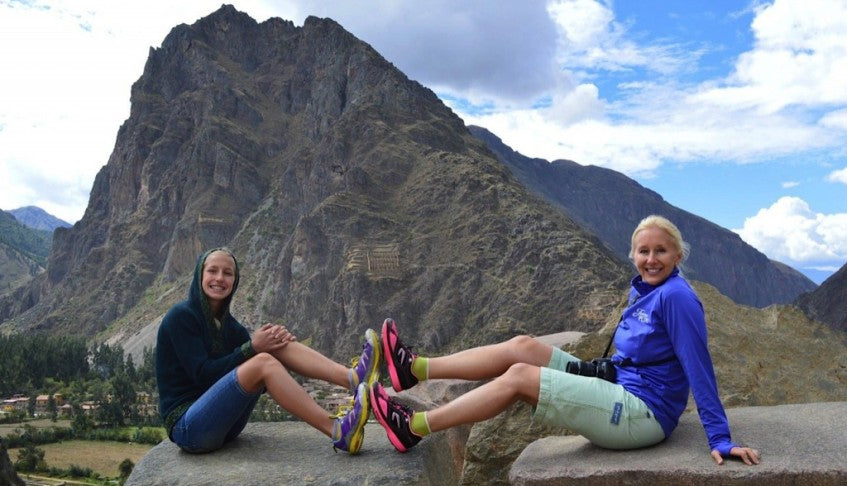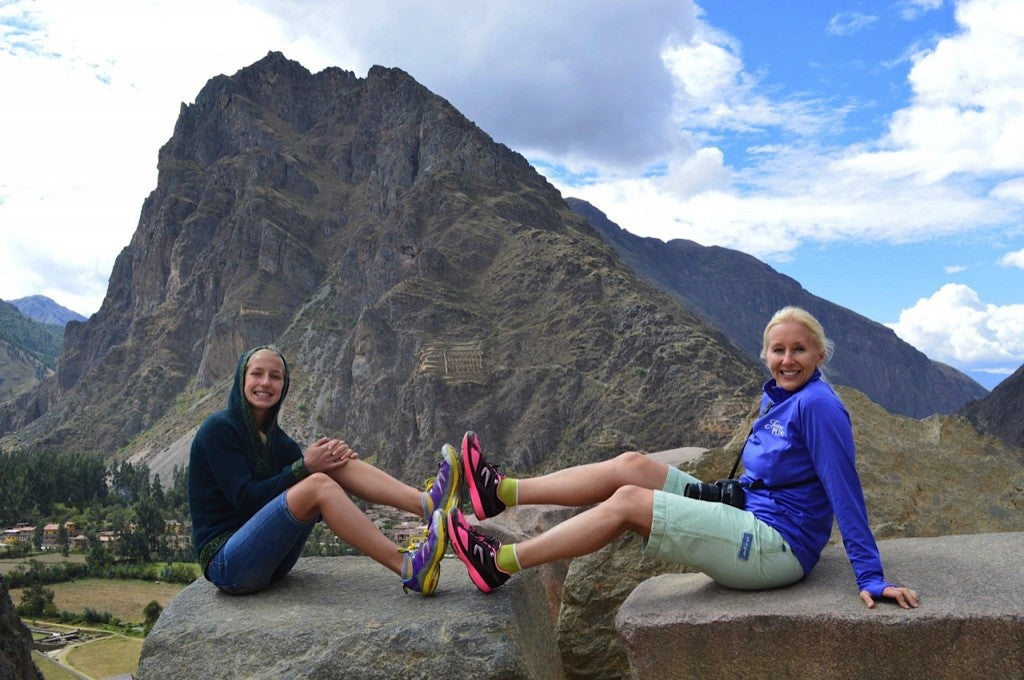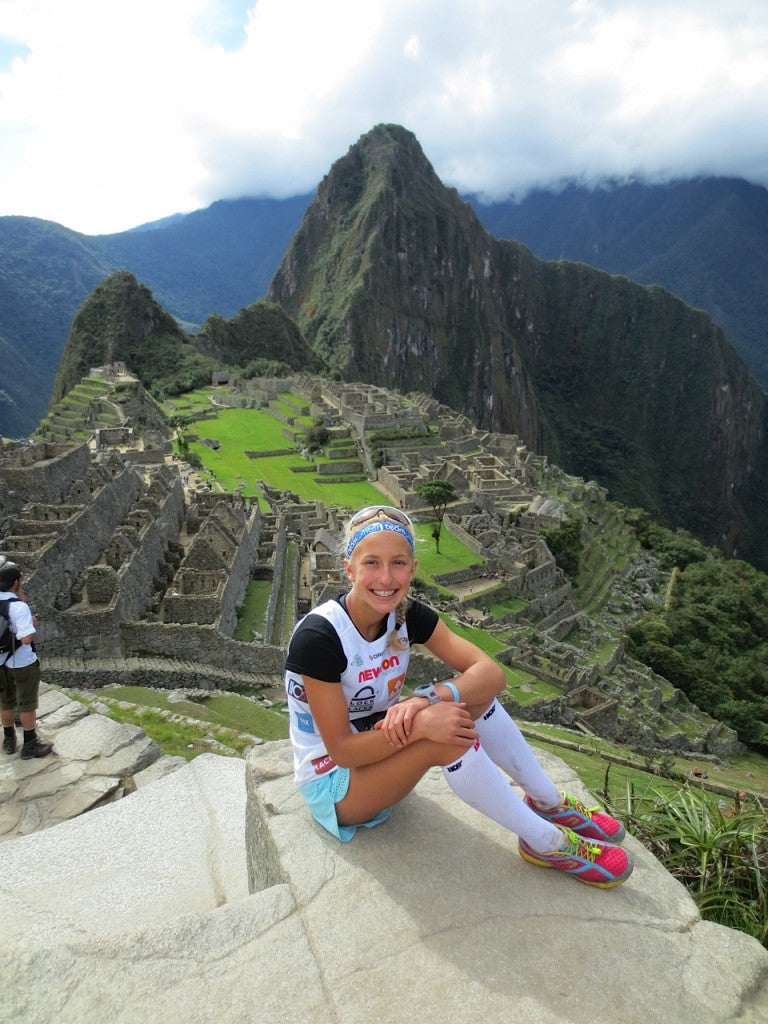
Never Give In: Running the Inca Trail Marathon
at the races charities newton running athletes uncategorized29 July 2013
Never Give In: Running the Inca Trail Marathon
How tough could running the Inca Trail be? Getting to the Inca Trail was much easier than Antarctica. No boats, no hurricane, just a 5-mile hike into the start line the day before the marathon. We arrived on a Saturday, a few days before the race, in a cute, little, town called Cusco, Peru. Here, we would spend several days acclimating to 12,000 feet and drinking lots of coca tea. The locals consider coca tea leaves to be the miracle plant for acclimatizing. Everywhere you go in Cusco, there are coca tea leaves, which you either chew or use to make tea.
I didn’t experience any significant issues going from 7,000 feet to 12,000 feet. Some people get nauseated, headaches, decreased appetite and even fatigue. We did several 4-5 mile downhill runs over the next couple days to get used to running in the altitude. Tuesday we hiked into our race camp near the start of the Inca Trail. We slept in tents and prepared for a 4 a.m. race start time. The park entrance into Machu Picchu closes at 3:30 p.m. every day. An early morning race start would give us 11.5 hours to reach this gate, which lies 2 miles from the actual finish line inside Machu Picchu. Those runners who don’t make the cutoff either camp out for the night on the Inca Trail at make shift camps set up by the race organizers, Andes Adventures, or take a path down to a different finish line below Machu Picchu.
Race night was short and not the most ideal preparation for a long running day. A 2 a.m. breakfast cooked by the Peruvian porters consisting of porridge, pancakes and bananas was definitely a good start though! There would be over 30 porters that would assist us on race day. They would carry our 22kg ration of gear we used for camping and assist us along the race course with water stops as well as encouragement and any other issues that might arise.
In the 18-year history of this race, only once had it rained! We can now make that twice! Within the first hundred yards of starting the marathon, raindrops began to fall, turning the trail into a rocky, muddy mess. The biggest obstacle to navigate in the first couple hours of darkness was the huge “cow pies” on the trail left by the farm animals that inhabited and roamed the first mountain pass. What a slippery mess they were! Once again it was the Newton trainers that served me well. I chose a lighter trainer shoe on the trails over the Newton trail shoe, but that is just my preference.
The toughest challenge may not have been the climate or the elevation. We would climb about 10,400 feet and descend 11,000 feet over the course of the day. I experienced some swelling in my fingers that was very noticeable as I reached Dead Woman’s Pass at 13,799 feet. After the race, I realized I wasn’t the only one experiencing this. It is common at these elevations to experience swelling in your extremities. My fingers looked like little sausages, but quickly went away after I descended to lower altitudes. The high altitude affected my normal race appetite also. I found myself not drinking and taking in the energy gels as planned.
Each of these marathons has been a great learning experience. I have become much better at listening to my body and adapting to the different challenges I face during these runs. Instead of only consuming my normal nutrition that had served me well in training runs, I had to switch it up and grab a cup of chicken broth. That seemed to work very well for me. My body was probably craving a little more sodium than usual. Despite my lack of thirst, I knew I was behind in my water intake and had to keep up on my hydration. My hydration pack made that much easier, since there was little effort needed to just take sips frequently along the way. Your hydration pack is crucial in these races. I had mine under my running jacket during the race so I didn’t have to remove my hydration pack each time I needed to put my jacket on or off. A hydration pack should just feel like a part of your body. The last thing you need to worry about is something bouncing on your back or chaffing you.
So what was the toughest challenge? The rocks and stone steps that lined the 26.2 miles of the Inca Trail were probably the biggest challenge of the day. Climbing the two-foot steps, which never seemed to end, provided a huge challenge to the hamstrings. I can’t even tell you how many false summits there are on that course. You think you are at the top and you get there and realize, “You’re not!” After all the long climbs, there would then be a long rocky descent, which entailed never-ending pounding to your feet on uneven stones. The descents were a true test of how well you had trained your quads. This was the first marathon that I wore my 110% Play Harder Compression Soxs during the race and not just for recovery after. I think it made a huge difference in how fresh my legs felt at the end of this grueling 9-hour run. You can bet you will see me running the longer distances in them in the future as well.
I never set out to win the Inca Trail Marathon. I just wanted to have the best possible race for me that day. The number “3” has been following me for a while, 3rd place overall female in Kenya and Antarctica Marathon! I am always thinking to myself, “Is today going to be the perfect race?” We must admit, we all dream of that perfect race or perfect competition. My training is always purposeful; I fuel my body nutritionally and prepare mentally for success as an athlete, especially as an endurance runner. The Inca Trail Marathon wasn’t the perfect race for me, but I was the best female runner given the circumstances on that course, on that given day. That race proved age is not a barrier and certainly, as the 4th place finisher overall that day, gender is not a barrier.
What do I remember most about that day? It probably isn’t standing on the finish line with my first overall female marathon win. It is the memories of me trying to race the porters on the descents and still not being able to keep up with them as they descended the stone paths with a 100-pound pack on their back. It was the reality that all the hikers I would pass on the Inca Trail that day would take 4-5 days to complete the Inca Trail, something I would complete in just 9 hours and 18 minutes. It was sharing my iphone the night before the race with two young Peruvian girls so they could play games and escape their isolated reality for a while. It was donating my clothing, as well as my brothers’ clothing, to the nearly 40 porters that would assist us on race day so that their families would have clothing. Or maybe it was waiting at the finish to not only see my mom run an 11 hour 20 minute marathon, but also to be on the podium with me as the 3rd place overall female.
The victory on the Inca Trail was not only a personal victory, but more importantly, a victory for prostate cancer awareness! Next stop is the Sunrise to Sunset Marathon in remote Mongolia at the end of this month. Following Mongolia is New Zealand and Athens, Greece later this year. In the end, I hope that I inspire others and teach the world to Never Give In. Never Give In despite the odds, despite your circumstances, despite your age, despite your gender, despite what others might say.
NEVER GIVE IN!
Join Team Winter or make a Donation!





